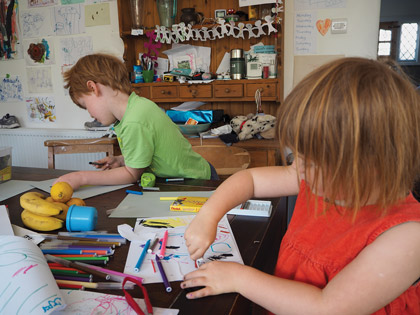3 William and Megan
Parents who home-educate their children in England are under no obligation to inform their local council, so the numbers of parents who decide to do this are not known. However, there is reason to think (see BBC News, 2015) that this total number may be increasing because of parental dissatisfaction with, for instance, the formal nature of schools, an inability of schools to meet the special needs that their children have, bullying between children, and the wish to pass on family and community religious beliefs in more concerted ways than might be done in schools.
Michael is the father of William (six years old) and Megan (three years old). As you read the following account of how he is home-educating his two children, focus on how the children’s views are accommodated each day and Michael’s reflections on his approach.
Box 2 Educating William and Megan
I haven’t gone back to work since William’s been about two so I’ve kind-of forgotten what it’s like to have a whole day to myself. With home education you really are around all the time with the children. I don’t think it’s nearly as hard as people might imagine it to be. The way we do home education is for them to play – that’s all they do really. Most of the time they’re exploring their ideas through play. It’s about communication, conversation and trying something out – experiments with ice, progressing their ideas for games, or examining stick insects, for instance.
We meet up with other parents and children all the time. William and Megan play very differently when we’re out with other children. William does have a tendency to run off with the older boys and they’ll do their own thing. A lot of Megan’s contemporaries aren’t that interested in group play. Sometimes she finds a little friend to play with. There are a couple of forest groups that we go to and it depends on who’s there as to how it unfolds.* We sometimes meet up in a forest and sometimes on a heath. The groups can be quite large when the weather’s good. We link up through social media but it’s also steered by word of mouth. When you’re starting out, you look at the big wide world of home education but then choose whatever works for you. Some parents initiate groups and activities. I tend to join groups rather than lead them. We may have ideas for activities but we often go with what the children want to do.
There’s quite an age gap between William and Megan so between them they tend to find a common denominator in their play, and they do play together quite well. When we’re in the house together, they’re often into their small world play characters. There’s a big castle and a doll’s house set up. Megan’s characters are living in the doll’s house and William’s are in the castle – true to their gender stereotypes. At first, Megan was immersed in William’s world of tractors and so on but she’s more into her own interests now like dressing up as a princess. I just let this happen because you’ve got a job on your hands to prevent it.
For a lot of the time today they were drawing little characters and cutting them out for their play. They were very productive and the characters were all over the table. Megan’s figurative drawing is coming along quite nicely. As soon as they draw them they act them out and move on to the next game. When they’re drawing it’s very verbal and their imagined people don’t seem to have much of a lifespan. With their small world play characters, they use them as a vehicle for their little adventures. They themselves also get dressed up. So, sometimes they project characters onto their toys and sometimes onto themselves. I used to have a role where I might get things going and they would then go with them. It’s less so these days because they’re sort of self-starting.
My background as a photographer, video engineer and someone who’s interested in science means I have always been an explorer and a life learner. I finished my science degree with The Open University when I was first looking after William. I just try to encourage them to be interested in the world around them and when you’ve got small children who are curious about everything, that’s not a difficult job. With our stick insects they used hand lenses to distinguish between what was poo and what were eggs. In their minds, this was fun and play. I don’t think children make the kind of distinctions between say play, fun, and exploration that adults can make.
There are some children who receive a very formal home education and they respond to it. The parents plan it out each term and tailor it to their child. Some home educators are teachers, of course. I expect the outcomes are very good. There is one child I know who is reading quite well at four. What’s nice about home education is you have the flexibility to do what you’re comfortable with. I do think I lean towards a holistic approach to learning.
* Note: a ‘forest’ approach offers children opportunities to achieve and develop confidence through hands-on learning in a natural environment.

